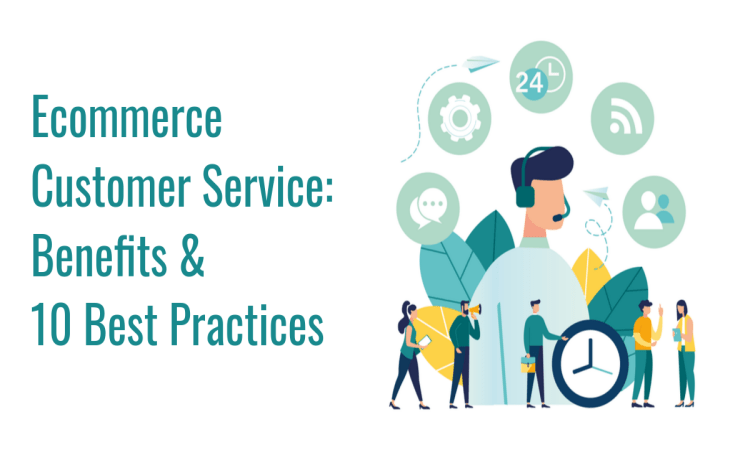Today's digital shoppers do not just expect that a purchase satisfies their needs. They want to enjoy the shopping experience and expect to be supported during their customer journey.
One factor that significantly impacts overall customer satisfaction is the quality of an ecommerce customer service. Not only that, as many as 95% of buyers say that customer service is the reason they remain loyal to a brand.
To stay competitive and attract repeat customers, ecommerce merchants employ a wide range of customer service strategies
If your customer service operation is due for an upgrade, consider giving the following 10 best practices a try.
What Is Ecommerce Customer Service?
Ecommerce customer service is the practice of assisting customers when they have a question or encounter a problem at some point in their customer journey. The goal of customer service is to:
- Help customers resolve issues before, during, and after the point of sale.
- Teach customers how to get the most out of products and services they have purchased.
- Work with customers to design better products and services.
Ecommerce customer service is about meeting customers on common ground to create a positive customer experience (CX) and incentivize further interactions with the business.
How to Improve Ecommerce Customer Service - 10 Best Practices
Unlike ecommerce marketing and sales, where off-the-wall creativity is encouraged and often rewarded, customer service benefits from a more down-to-earth approach. In other words, consistency takes precedence over innovation.
With that in mind, here are 10 customer service best practices with a good track record in the ecommerce industry.
1. Make Your Customer Service Omnichannel

The omnichannel approach in ecommerce is becoming a necessity. To be successful, it must include customer service.
Omnichannel customer service means that all the channels through which customers initiate contact (email, live chat, social media, etc.) are integrated within a single system. The key feature of this approach is the seamless transition between channels. When switching, customers simply pick up where they left off.
One of the chief complaints customers have is that they have to repeat their problem to different customer service agents. With the omnichannel approach, a customer who writes an email requesting assistance gets a phone call the next day from an agent who knows exactly what the problem is and how to solve it. Keeping a record of all interactions in one place preserves context and reduces customer friction.
2. Personalize Customer Service Interactions
Building on the previous point, ecommerce customer service benefits greatly from a personalized approach. Taking the time to address each customer as an individual with a specific set of needs and preferences is crucial for developing a long-term relationship.
Ecommerce personalization comes in many forms and includes anything from delivering personalized offers and deals to providing custom product solutions. In the sphere of customer service, personalization means that agents have before them information on the customer, including their purchase history and previous communication. With this knowledge, the customer service representative can approach the customer as a person whose desires and problems are understood and respected.
3. Improve Customer Service Response Time

One of the top customer service UX factors is response time. A timely response lays the groundwork for long-term customer satisfaction, better branding outcomes, and increased upselling and cross-selling potential.
A delayed response leads to lost sales opportunities, bad-mouthing on social media, negative branding, and an increase in chargebacks and refund requests.
To ensure your customer service responds in a timely manner, consider using the following tactics:
- Hire region-specific customer service representatives to enable global, 24/7 customer service.
- Set up customer service notifications in your CRM tool of choice.
- Send automatic response emails upon receiving customer service requests.
- Reach out after customer service interventions to gauge customer sentiment.
4. Maintain a Customer Service Knowledge Base
When faced with a problem or query, many customers first try to find a solution themselves. Maintaining an up-to-date knowledge base (KB) is one of the ways you can empower buyers to solve their own problems.
Giving customers access to a collection of documents, videos, and guides reduces the need for direct interaction and frees up your customer service reps for other tasks, such as handling more complex issues and dealing with priority clients.
5. Keep Track of Customer Feedback

In ecommerce, customer service is often the first instance of direct business-to-customer interaction. This interaction acts as the baseline for all further interactions and is often the thing about which customers have the most definite opinions.
Keeping track of customer feedback is therefore essential for optimizing the customer service process.
There are many ways to collect customer feedback, including:
- Asking customers to fill out a customer service review form after an interaction.
- Exploring the comments section on your blog and your social media pages.
- Conducting social media surveys.
Note: For an in-depth look at customer feedback, read our article What Is Customer Feedback and Why Is It Important.
6. Offer Live Chat Support
Live chat is one of the most effective customer service channels available to ecommerce businesses. The three main benefits of live chat are timely responses, personalization, and engagement.
Live chat is about being where the customers are at all times and providing actionable solutions to specific problems.
The main issue with live customer service is that it can be quite difficult to implement and maintain, especially for businesses with a small customer service staff. One possible solution is to utilize ecommerce chatbots in addition to live service reps.
Chatbots can be customized to:
- Answer common customer queries.
- Provide 24/7 global customer support.
- Perform on-site actions such as making reservations, linking to KB articles, or adding items to the shopping cart.
- Collect customer data.
This makes chatbots a viable alternative or a powerful complement to your customer service live chat operation.
7. Provide a FAQ Page

FAQs are an easy way to offer customer service in scenarios when you are operating an ecommerce store with a limited budget and staff.
When creating an FAQ section, it is not enough to just follow existing templates from other ecommerce websites. Instead, try to figure out what matters to your customers specifically, taking into account the data you have at your disposal, including:
- Live-chat transcripts
- Customer account information
- Customer purchase history
- Relevant SEO keywords relating to your products and services
8. Design Customer Service Response Templates
Consistency is essential for ecommerce customer service. Consistent customer service output generates consistent customer expectations. Meeting these expectations further leads to dependable ecommerce outcomes, such as more sales, increased customer lifetime value, and better customer feedback.
One of the ways to ensure customer service consistency is to design customer service response templates. These predefined responses work in favor of customers, as well as your customer service reps.
On the customer side, using response templates portrays your business as reliable, pragmatic, and quick to respond.
On the side of the customer service representative, response templates make it easier to organize workloads, resolve low-priority issues faster, and tackle multiple service tickets at the same time.
9. Create Customer Service Videos

Video is one of the most effective tools ecommerce businesses have at their disposal. It provides unparalleled engagement, high information density, and easy distribution.
In customer service, videos can be used for a variety of purposes. The most common formats are:
- Video guides illustrating product features, use-cases, and benefits.
- Video FAQs that answer common customer questions.
- Troubleshooting videos with tutorials on how to solve product-related issues.
10. Align Customer Service with Marketing and Sales
This strategy for improving customer service treats marketing, sales, and customer service as three elements of a single revenue-generating process. Here is how these three sectors interact to create a unified whole:
- Marketing teams attract leads according to criteria provided by sales and customer service agents based on their first-hand interactions with customers.
- Sales teams leverage marketing materials and customer service tactics to more effectively land the sale.
- Customer service teams make good on the promises made by marketing and sales, keeping customers invested in your brand for future sales opportunities.
Benefits of Good Ecommerce Customer Service
The benefits of good ecommerce customer service cannot be understated. It is one of the ways a brand can stand out in a highly competitive environment.
Any investment a company makes in customer service is sure to bring back good returns. Thoughtful and fast responses to customers' queries and frustrations result in the following:
- Easier customer acquisition. Before committing to a purchase, prospects have questions. A fast and accurate response from a customer service representative helps turn leads into buyers.
- Greater customer loyalty. Customers whose previous shopping experience has been pleasant will remember your brand and come back for more.
- Increased customer lifetime value. An American Express study shows that customers are willing to spend more with a company from which they receive good customer service.
- Positive word-of-mouth. The same study cites that as many as 9 in 10 Americans tell others when they have a positive customer experience; they also tend share their experience on social media.
Conclusion
Customer service is a key factor of ecommerce success. Its role is to maintain your existing customer base and keep it happy, engaged, and primed for future interactions.
If your customer service efforts are bringing lackluster results, give these 10 strategies a try and start improving your ecommerce outcomes.
